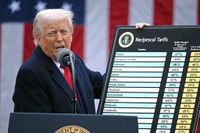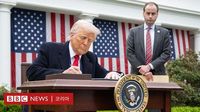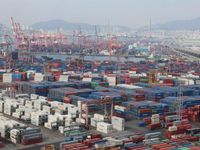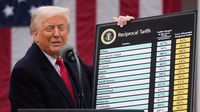On April 1, 2025, Donald Trump announced a sweeping new reciprocal tariff plan that is expected to send shockwaves through the global economy. Speaking from the Rose Garden at the White House, Trump declared that the United States would impose a base tariff of 10% on all imports, effective April 5, 2025, and announced higher tariffs for approximately 60 countries deemed "the worst offenders" in trade practices. This announcement marks a significant shift in U.S. trade policy, expanding previously targeted tariffs to a broader range of nations.
The countries subject to the base tariff include the UK, Singapore, Brazil, Australia, New Zealand, Turkey, Colombia, Argentina, El Salvador, the Arab Emirates, and Saudi Arabia. Trump emphasized that the tariffs are a necessary response to longstanding trade imbalances, stating, "For decades, the United States has been exploited by both friends and foes alike." He described the day of the announcement as a "Liberation Day," claiming it would mark the rebirth of American industry and restore the nation’s economic strength.
However, the specifics of the reciprocal tariffs are more contentious. Starting April 9, 2025, higher tariffs will be imposed on countries like South Korea (25%), the European Union (20%), China (34%), Vietnam (46%), Thailand (36%), Japan (24%), Cambodia (49%), South Africa (30%), and Taiwan (32%). Notably, Canada and Mexico are excluded from these new tariffs, as the U.S. maintains a framework with these countries to address issues such as the opioid crisis.
In a departure from previous tariffs, Trump announced a 25% tariff on all foreign-made automobiles, which began on April 3, 2025. This move has raised concerns among auto manufacturers and consumers alike, as it could significantly increase the prices of vehicles in the U.S. market. Trump indicated that these tariffs were a response to non-tariff barriers imposed by other countries, particularly South Korea, which he claimed effectively impose tariffs of 50% to 513% through various regulatory measures.
Critics of the tariff plan have expressed alarm over its potential impact. Bernd Lange, the EU's trade commissioner, condemned the tariffs as "unfair, illegal, and unbalanced," dubbing the day of the announcement "Inflation Day" instead of "Liberation Day." Manfred Weber, leader of the European People's Party, echoed this sentiment, asserting that tariffs do not benefit anyone and calling it "Division Day." He emphasized that the U.S. tariffs are driven by fear rather than fair trade practices.
International reactions have been swift and critical. Japan's Minister of Economy, Trade, and Industry, Yoji Muto, expressed regret over the tariffs, stating that the country would investigate their impact on Japanese industry and take necessary measures. Australia’s Prime Minister Anthony Albanese criticized the tariffs as unfair, arguing that the biggest costs would ultimately be borne by American consumers.
China's Ministry of Commerce labeled the tariffs a hegemonic act that violates international trade rules, urging the U.S. to withdraw the measures and resolve disputes through equal dialogue. The Chinese government has been particularly vocal, highlighting that the tariffs undermine years of multilateral trade agreements and negotiations.
Goldman Sachs has projected that the likelihood of a U.S. recession within the next year has risen from 20% to 35% due to the economic uncertainty created by these tariffs. The firm warned that rising prices on thousands of goods could lead to decreased demand, further straining the economy.
Trump’s administration has framed these tariffs as necessary to protect American jobs and industries from unfair competition. However, many economists warn that the tariffs could backfire, leading to higher prices for consumers and potential retaliation from affected countries. The global trading environment is now facing increased uncertainty, with countries like the EU and China poised to respond with their own tariffs.
In summary, the new reciprocal tariff plan announced by Trump represents a dramatic escalation in U.S. trade policy, affecting a wide array of countries and industries. As the situation unfolds, the potential for trade wars looms large, raising questions about the long-term implications for both the U.S. and global economies. The coming weeks will be crucial as nations respond to these tariffs and seek to navigate the shifting landscape of international trade.




